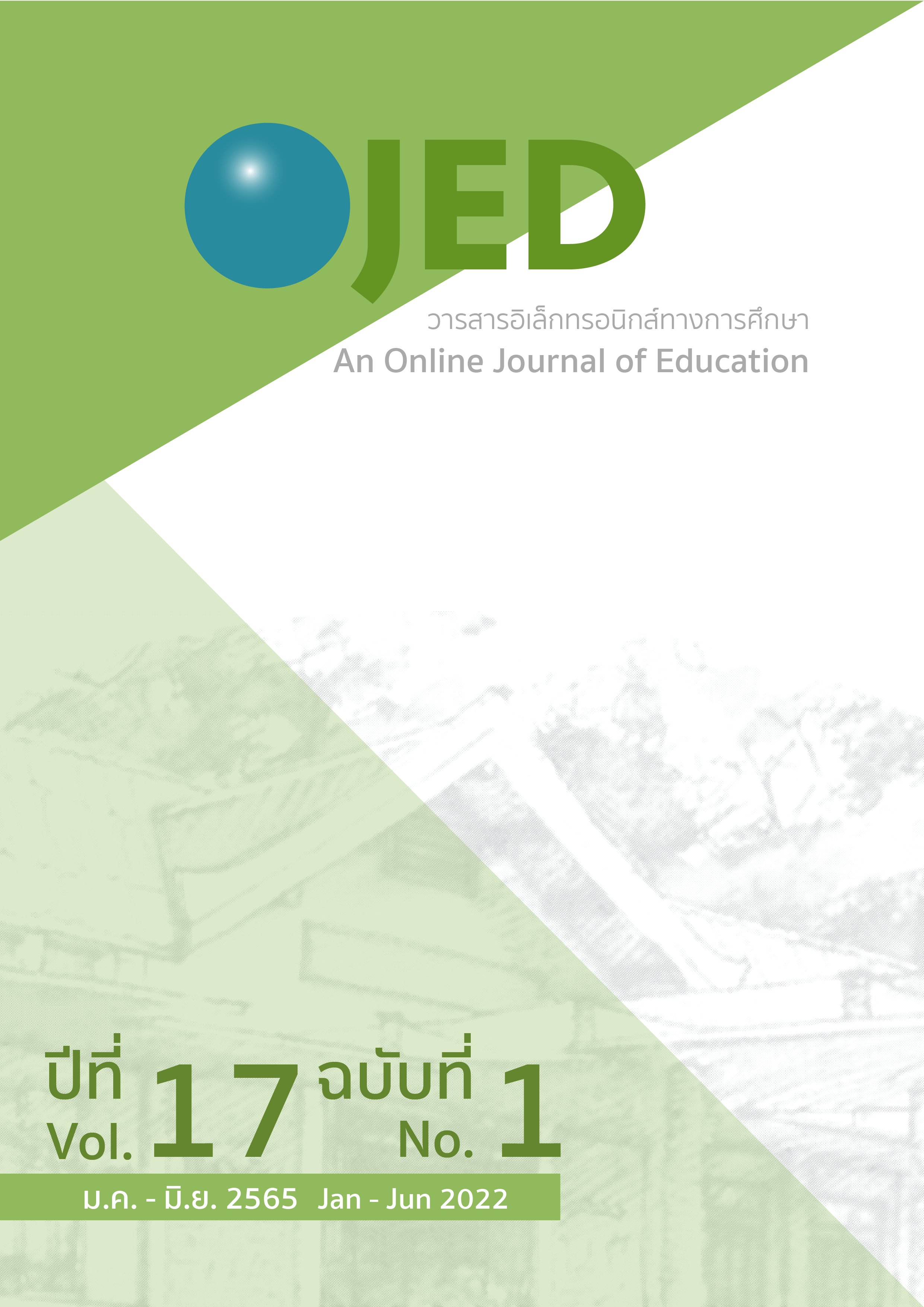Effects of Organizing Mathematics Learning Activities Using Worked Examples on Mathematical Knowledge and Communication Abilities of Ninth Grade Students
DOI:
https://doi.org/10.14456/ojed.2022.3Keywords:
worked examples, mathematical knowledge, mathematical communication abilityAbstract
The purposes of this research were 1) to compare the mathematical knowledge of the students after being taught using organizing mathematics learning activities to the criteria score 60%, 2) to compare the mathematical communication abilities of the students before and after being taught using organizing mathematics learning activities, and 3) to compare the mathematical communication abilities of the student after being taught using organizing mathematics learning activities to the criteria score 60%. The subjects were 35 ninth grade students from an extra-large school under the office of Secondary Educational Service Area 1 in Ratchathewi district, Bangkok. The instruments used for data collection included a mathematical knowledge test, mathematical communication abilities tests and interview record form. The data were analyzed using arithmetic mean, standard deviation, and t-test. The results of the research revealed that 1) the mathematical knowledge of the students after being taught using organizing mathematics learning activities were higher than the minimum criteria of 60% at the .05 level of significance, 2) the mathematical communication abilities of the students after being taught using organizing mathematics learning activities were higher than those of the students before being taught using organizing mathematics learning activities at the .05 level of significance, and 3) the mathematical communication abilities of the students after being taught using organizing mathematics learning activities were lower than the minimum criteria of 60% at the .05 level of significance.
References
จิรรัตน์ จตุรานนท์. (2554). การศึกษาความรู้คณิตศาสตร์ ทักษะและกระบวนการทางคณิตศาสตร์ และความคิดเห็นเกี่ยวกับการเรียนการสอนของนิสิตนักศึกษาครุศาสตร์ [วิทยานิพนธ์ปริญญามหาบัณฑิต ไม่ได้ตีพิมพ์]. จุฬาลงกรณ์มหาวิทยาลัย.
พรรณทิพา พรหมรักษ์. (2552). การพัฒนากระบวนการเรียนการสอนโดยใช้กระบวนการวางนัยทั่วไปเพื่อส่งเสริมความสามารถในการให้เหตุผลทางพีชคณิตและการสื่อสารทางคณิตศาสตร์ของนักเรียนมัธยมศึกษาปีที่ 3 [วิทยานิพนธ์ปริญญาดุษฎีบัณฑิต ไม่ได้ตีพิมพ์]. จุฬาลงกรณ์มหาวิทยาลัย.
ณิชาพร เจริญวานิชกูร. (2559). ผลของการจัดกิจกรรมการเรียนรู้คณิตศาสตร์โดยใช้รูปแบบการเรียนการสอนตามแนวคิดของ MAYNES และ SCOTT ที่มีต่อความรู้ทางคณิตศาสตร์และความสามารถในการแก้ปัญหาทางคณิตศาสตร์ของนักเรียนมัธยมศึกษาปีที่ 5 [วิทยานิพนธ์ปริญญามหาบัณฑิต ไม่ได้ตีพิมพ์]. จุฬาลงกรณ์มหาวิทยาลัย.
สถาบันส่งเสริมการสอนวิทยาศาสตร์และเทคโนโลยี (สสวท.). (2555). การวัดผลประเมินคณิตศาสตร์. ซีเอ็ดยูเคชั่น.
สถาบันทดสอบการศึกษาแห่งชาติ. (2562ก). ผลการประเมิน PISA 2018. Google Drive. https://drive.google.com/file/d/18DKqGcId1dN6IWF07TXG8YZsQOg-NlWZ
สถาบันทดสอบการศึกษาแห่งชาติ. (2562ข). รายงานผลทดสอบทางการศึกษาระดับชาติขั้นพื้นฐาน (O-NET) ม.3 ปีการศึกษา 2561. https://www.niets.or.th/th/catalog/view/280
สุพัตรา จอมคำสิงห์. (2552). ผลของการจัดกิจกรรมการเรียนรู้คณิตศาสตร์โดยใช้ตัวอย่างงานที่มีต่อความสามารถในการแก้ปัญหาคณิตศาสตร์ และความคงทนในการเรียนคณิตศาสตร์ของนักเรียนมัธยมศึกษาปีที่ 3 [วิทยานิพนธ์ปริญญามหาบัณฑิต ไม่ได้ตีพิมพ์]. จุฬาลงกรณ์มหาวิทยาลัย.
อัมพร ม้าคนอง. (2553). ทักษะและกระบวนการทางคณิตศาสตร์ : การพัฒนาเพื่อพัฒนาการ. ศูนย์ตำราและเอกสารทางวิชาการ คณะครุศาสตร์ จุฬาลงกรณ์มหาวิทยาลัย.
อัมพร ม้าคนอง. (2557). คณิตศาสตร์สำหรับครูมัธยม. ศูนย์ตำราและเอกสารทางวิชาการ คณะครุศาสตร์ จุฬาลงกรณ์มหาวิทยาลัย.
Ausubel, D.P. (1968). Educational psychology: A cognitive view. Holt Rinegart and Winiston.
Booth, J. L., McGinn, K. M., Young, L. K., & Barbieri, C. (2015). Simple practice doesn’t always make perfect: Evidence from the worked example effect. Policy Insights from the Behavioral and Brain Sciences, 2(1), 24-32.
Buschman, L. (1995). Communicating in the language of mathematics. Teaching Children Mathematics, 1(6), 324-330.
Huang, X. (2007). The effect of different types of worked examples on student learning and transfer of a problem-solving task. http://purl.flvc.org/fsu/fd/FSU_migr_etd-3679
Kennedy, L., & Tipps, S. (1994). Guiding children's learning of mathematics. Woodworth Publishing.
Klausmeier, H. J., & Ripple, R. E. (1971). Learning and human abilities. Educational psychology. Harper Row.
Mumme, J., & Shepherd, N. (1993). Communication in mathematics in implementing the K-8 curriculum and evaluation standard. National Council of Teachers of Mathematics.
National Council of Teachers of Mathematics [NCTM]. (2000). Principles and standards for school mathematics. National Council of Teachers of Mathematics.
Renkl, A. (2002). Worked-out examples: Instructional explanations support learning by self-explanations. Learning and instruction, 12(5), 529-556.
Renkl, A. (2011). Instruction based on examples. Handbook of research on learning and instruction, 272–295.
Retnowati, E., Ayres, P., & Sweller, J. (2010). Worked example effects in individual and group work settings. Educational Psychology, 30(3), 349-367.
Rodiawati, A. (2018). Worked example using ILL-structured problem: Trained high order thinking skill. AKSIOMA Jurnal Program Studi Pendidikan Matematika, 7(2), 308-313.
Rowan, T. E., & Morrow, J. L. (1993). Implementing the K-8 curriculum and evaluation standard: The arithmetic teacher. National Council of Teachers of Mathematics.
Sweller, J., & Cooper, G. A. (1985). The use of worked examples as a substitute for problem solving in learning algebra. Cognition and Instruction, 2, 59-89.
Van Gog, T., Paas, F., & Van Merriënboer, J. J. (2008). Effects of studying sequences of process-oriented and product-oriented worked examples on troubleshooting transfer efficiency. Learning and Instruction, 18(3), 211-222.
Downloads
Published
How to Cite
Issue
Section
License
Copyright (c) 2022 An Online Journal of Education

This work is licensed under a Creative Commons Attribution-NonCommercial-NoDerivatives 4.0 International License.




